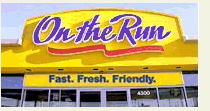 |

From run-of-the-mill convenience stores to the
most exciting, breakthrough concept to hit the
market in decades.
Background
- The idea of convenience stores, a quick and easy format for picking up
the one or two items missed at the grocery store, quickly caught on and
spread like wild fire across America during the 1960s and 70s.
- By the 1980s the market was completely saturated.
- During the recession of the early 90s, sales at convenience stores
plummeted and some locations were forced to close.
- As it prepared to launch a new service-focused strategy for its service
stations, Mobil wondered whether its convenience store business could
be improved dramatically.
Diagnosis
- Convenience stores in general had become inconvenient. Parking was
frequently a problem; product selection varied from week to week; checkout
was often slow.
- Though prices had gone up, overall quality was down. Food products
weren’t fresh; stores neglected basic upkeep such as changing light
bulbs; cleanliness was a problem.
- Customer service was generally sub-par and unresponsive to customer
needs.
- The primary customers were blue-collar men stopping by to buy
cigarettes, a Mountain Dew, and lottery tickets.
Strategic Research
- A large-scale study was undertaken among a national sample of 1000
convenience store customers and prospects, as well as a study among
convenience store managers and employees.
- The needs, problems, and motivations of each group were measured.
- In addition, a concept engineering study among 600 convenience store
patrons was undertaken to identify the financially optimal configuration of
name, service design, store layout, merchandising, product selection, and
service.
- This was followed by simulation modeling to identify a financially optimal
plan.
Strategic Options
- Mobil could get out of the convenience store business.
- Mobil could keep the stores it had and build more larger convenience
store locations.
- Mobil could keep the stores it had and build more smaller, limited menu
convenience store locations.
- Mobil could introduce an entirely new and different convenience store
concept—a store that would transform the industry.
Strategic Choice
- Mobil chose the fourth option and created an entirely new convenience
store concept called “On The Run.”
- The company decided to introduce stand alone stores that were separate
from service stations in terms of visual and brand identity, name and
color-scheme, and put the “convenience” back in convenience stores:
- “Fast, Fresh, and Friendly”: Open, clean stores with fresh product selection and
ready-to-eat items with fast check-out and helpful, friendly service.
- “The convenience store where quality is the ultimate convenience.”
Performance Results
- On The Run quickly gained industry notoriety as a breakthrough concept.
- Along with industry accolades, overwhelmingly positive customer
response prompted ExxonMobil to commit more than half-billion dollars
over five years to expand On The Run to more Exxon and Mobil service
stations.
- Same-store sales have consistently shown strong growth of more than 10
percent per year since 1998.
- There are now more than 1700 locations in 41 countries.
|

|
